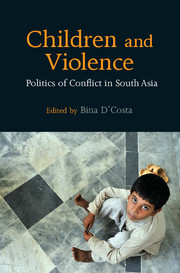Book contents
- Frontmatter
- Dedication
- Contents
- List of Map, Figures and Tables
- Acknowledgements
- Introduction: ‘Turtles Can Fly’: Vicarious Terror and the Child in South Asia
- Part I Shaping Childhood in South Asia
- Part II Conflict and Violent Peace
- Part III Rights, Needs and Protection
- 8 Children Affected by Political Violence in India: Human Rights, Politics and Protection
- 9 Rethinking Rights and Needs: The Everyday Life of Refugee Children in the Borderland
- 10 Pinning Down a Paper Tiger: Some Practice Observations on the Monitoring and Reporting Mechanism in Nepal and Asian Contexts
- Part IV Reflections from Human Rights Advocates in the Region
- Bibliography
- Notes on Contributors
- Index
10 - Pinning Down a Paper Tiger: Some Practice Observations on the Monitoring and Reporting Mechanism in Nepal and Asian Contexts
from Part III - Rights, Needs and Protection
Published online by Cambridge University Press: 05 June 2016
- Frontmatter
- Dedication
- Contents
- List of Map, Figures and Tables
- Acknowledgements
- Introduction: ‘Turtles Can Fly’: Vicarious Terror and the Child in South Asia
- Part I Shaping Childhood in South Asia
- Part II Conflict and Violent Peace
- Part III Rights, Needs and Protection
- 8 Children Affected by Political Violence in India: Human Rights, Politics and Protection
- 9 Rethinking Rights and Needs: The Everyday Life of Refugee Children in the Borderland
- 10 Pinning Down a Paper Tiger: Some Practice Observations on the Monitoring and Reporting Mechanism in Nepal and Asian Contexts
- Part IV Reflections from Human Rights Advocates in the Region
- Bibliography
- Notes on Contributors
- Index
Summary
Protecting children from harm is enshrined in the Convention on the Rights of the Child (CRC). Despite being the most widely ratified human rights treaty in history, in situations of armed conflict children's basic rights are often disregarded. During war their particular vulnerabilities to exploitation, abuse and violence are now normatively understood among the international community at large. Yet, it was not until recently that a number of concrete measures have been put in place to protect children in situations of armed conflict. In particular, Security Council Resolutions 1261 (1999) and 1612 (2005) have enhanced ability and obligation to gather evidence, report and stop the gravest violations against children, through the Monitoring and Reporting Mechanism (MRM).
The UN led MRM, established in 2005, ultimately, provides a platform for humanitarian and development agencies to work together with perpetrators of child rights violations in order to improve child protection. The MRM provides a multi-scale scheme for gathering timely and reliable information on grave child rights violations, a public list of armed groups and government forces who commit crimes, and a planning process to stop and prevent violations and rehabilitate affected children (UN, 2005). MRM Action Plans are time-bound agreements that spell out activities to haltviolations (such as discharging those under 18 from army ranks) and preventviolations (such as strengthening measures for the prevention of underage recruitment). In practice, these new tools for addressing grave child rights violations in the negotiation and advocacy repertoire play out differently in different armed conflict contexts.
The MRM is operational, to varying extents, in 23 country situations. As early as the first year of its application, Asia has hosted countries using the MRM. Many Asian countries experience or have experienced multiple forms and levels of conflict concurrently, with significant proportions of the civilian population, including children, affected by low-intensity and episodic insurgency and counterinsurgency campaigns. Five South and Southeast Asian countries have hosted armed forces or groups that have been or still are listed for child rights violations. These countries are Sri Lanka, Nepal, the Philippines, Myanmar and Afghanistan where children have been used or recruited in fighting forces or groups. Many of these parties are persistent child rights violators – parties in Nepal, the Philippines and Myanmar have been listed for at least five years.
- Type
- Chapter
- Information
- Children and ViolencePolitics of Conflict in South Asia, pp. 243 - 274Publisher: Cambridge University PressPrint publication year: 2016



